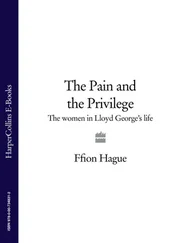55
Svetlana’s education was sketchy, a consequence not only of her constant uprooting, but of her mother’s artistic inclinations and Wrieto-San’s antipathy for formal instruction. Iovanna’s case was even worse. She was functionally illiterate when I met her in 1932 and she did not attend school until two years later, at the age of nine, when she had to be held back from the fourth grade in Spring Green because she hadn’t yet learned her alphabet.
56
Yes, and how much would that lamp be worth today?
57
Wrieto-San’s complaints over the chaos fomented by his six children with Catherine are legendary. For all his talk of the sanctity of family — and the conceit was central to his philosophy, along with a firm belief in independence of spirit, pioneer gumption and a don’t-tread-on-me mentality — he seems to have been the sort of man who preferred family life in the abstract to the actuality. But then what man hasn’t, at least on occasion, found himself deeply disillusioned with the distracted wife, the night alarums and the diaper pail, not to mention the expressive howls and systematic material destruction of the growing child?
58
Judge Levi H. Bancroft, who, along with Wrieto-San’s old friend Judge James Hill, was representing Wrieto-San’s interests in the divorce suit. Both he and Judge Hill were eminently capable men — as capable, some would say, as Clarence Darrow, who’d defended Wrieto-San against an earlier charge of violating the Mann Act (in transporting Miriam across state lines in 1915 for allegedly immoral purposes, if sexual congress between consenting adults on any side of any artificial boundary can be seen as immoral). But then, Wrieto-San always surrounded himself with the best of everything, including people.
59
Miriam, in a fugue of litigious ecstasy, had filed an additional suit against Wrieto-San for involuntary bankruptcy and pressed for his arrest on Mann Act charges, an irony that certainly wouldn’t have eluded her.
60
I’ve often wondered if Wrieto-San chose this pseudonym in honor of Henry Hobhouse Richardson, one of the luminaries of the Arts and Crafts movement, whose bold primitive stonework prefigures not only Taliesin but the Imperial Hotel and the Los Angeles houses as well. Unfortunately, I was never able to ask him, because, as you might imagine, it would have been awkward in the extreme even to make casual reference to this period of Wrieto-San’s life, when he was a plaything of the press, bankrupt and bereft of commissions, the “fugitive architect” fleeing the authorities in all the fullness of his white-haired glory.
61
Wrieto-San, in his ineffably charming and charismatic way, had persuaded the owner of the cottage (a Mrs. Simpson; we don’t have a given name for her) that she needed a vacation for a three-month period so that she might rent him her house, fully furnished, and rent him her housekeeper too. How he paid for this — or rather if he paid for it — remains a mystery.
62
Another of those felicitous American expressions, deriving, I presume, from the odor of suspect fish. Of course, we Japanese, as an island people, have a great respect for the utility of all the creatures of the sea, and we would never dream of preparing a fish for sashimi, sushi or even stock for ramen without either seeing it caught personally or giving it a good, long and thorough sniff. And while this isn’t the place for animadversions, I can’t help saying that what passes for “fresh fish” in America wouldn’t serve as offal for the cats in Japan — and our cats don’t really eat all that well.
63
Wrieto-San is not at his best in these photos, less master of the situation than mastered by it. He seems befuddled, as if he’s just realized that he’s put on some stranger’s coat and hat and taken up an ersatz cane. And I mean no disrespect, but in studying these pictures, I have to say that he looks woefully ordinary, like a podgy shoe salesman wandering the aisles or the owner of a delicatessen who can’t seem to remember what he’s done with the sliced bologna.
64
When I first acquired this term, I kept pronouncing it with an extra syllable, voicing the intercalary e, all but certain it must have been of Norwegian derivation. It is, in fact, a corruption of the Spanish: juzgado, sentenced, from the verb juzgar, to judge. In attempting to make light of what must have been among the most painful periods of his life, Wrieto-San had this to say of his decline and fall: he had gone “From Who’s Who to the Hoosegow.”
65
For five hours, according to the Chicago Tribune . One would like to have been privy to that meeting.
66
Carl Sandburg prominent among them. But perhaps the “kicker” with regard to public sympathy was his first wife’s unflagging defense of him — astonishingly, Kitty announced to the press that she was prepared to come up to Minneapolis and stand by him in his time of need. Now, I never met her and cannot speak either to her motives or her mental state at this juncture, but one has to marvel at Wrieto-San’s magnetism and his ability to have such a lasting effect on a woman he’d turned his back on. Twice.
67
Miss Tillie Cecille Levin. Presumably, at this juncture, Miss Levin was more attentive to her needs, both real and imagined, than Mr. Fake.
68
Wrieto-San valued the collection at $100,000, and though, as I say, he continually over-valued practically everything he owned, he was perhaps at least somewhat accurate here, as the government of my country, alarmed at the way in which foreign collectors were depleting the stock of indigenous art, had strictly limited the export of these prints, thus driving up the price of those already in private collections. Hiroshige’s masterwork, Monkey Bridge in Kai Province ( Kōyō Saruhashi no zu ), an exquisite double vertical ōban, was among the rare pieces up for auction, but Wrieto-San, because this was in effect a fire sale, actually received less for it than he’d paid some years earlier.
69
And how, one asks, did Wrieto-San expect to pay out this amount in cash? Ingeniously, and with the cunning that characterized his financial dealings throughout his life, he persuaded a group of friends to incorporate him — as Frank Lloyd Wright, Inc. — against future earnings, at a cost to each of $7,500. Which, needless to say, none of them ever saw again.
70
Wisconsin law at the time prescribed a one-year waiting period before remarrying.
71
Actually, at this point the bank still owned Taliesin, though Wrieto-San’s friends were negotiating for a grace period with regard to the outstanding debt. He was living with his sister Jennie in her house (Tan-y-deri) on the Taliesin grounds, however, and doing his best to repair damage from yet another fire that had occurred in his absence. (And what is it with this man and fire?)
72
This would have been at the instigation of Albert Chase McArthur, who hired Wrieto-San as consulting architect for the Biltmore Hotel in Phoenix for the sum of $1,000 a month, which monies Wrieto-San must sorely have needed at this juncture. It should be said in this connection that while McArthur is officially credited for the design, which makes use of the textile-block construction Wrieto-San pioneered in the Los Angeles houses, anyone with the least sensitivity to architecture can see that this is quite clearly one of Wrieto-San’s buildings in all but name.
73
Niijima, possibly, popular these days with surfers.
74
She was fifty-nine at the time.
75
ARCHITECT WRIGHT MARRIES DANCER, the headlines read.
76
By the corporation, which was soon to go bankrupt.
77
Within three months of their arrival in the fall of 1928, they were off to Arizona (with a party of fifteen, including draftsmen, the cook and Billy Weston and the pie-in-the-sky prospect of a hotel, San Marcos in the Desert, which would, alas, never be built).
Читать дальше












